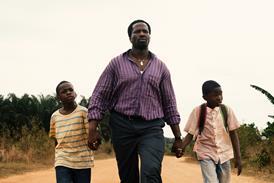Dir. Hideaki Anno, Kazuya Tsurumaki,Masayuki. Japan, 2007. 98 min.
Pusan's closing night film is brash, loud, colourful but pretty confusing if you are not acquainted withthe ins and outs of the original 1995 anime TV series. It is already a hit in Japan where millions watched its final television episode. But itshouldfind an early-teens audience anywhere aware of its mythology.
For those unfamiliar with the concept, it all takes place in the very near future, starting onlyeight years from now. The world undergoes a major catastrophe which has done away with half the human race.
The villains are the Angels, a mythical undefined creatures from outer space capable of resisting any type of human weapon.Theyare determined to put an end to the human race and return for another attack.
The only possible defense against them are the Evangelion. Thesegigantic and sophisticated humanoid fighting machines have to be operated only by a certain kind of 14-years-olds, born exactly nine months after the original Angels visit.
All of this is hinted at, without any particular explanation, or skipped out altogether in the present film.
The creator of Eva (as the Evangelion is known to intimates) is a cold ruthless scientist called Ikari, and the film starts at the point where his son, Shinji, is drafted as the next in line to pilot the machine, after the predecessor, Rei, a girl of his own age, has been gravely hurt in an Angel attack.
Unwilling and unprepared for the task, Shinji is pretty mucha recluse and has a serious self-esteem problem, feeling unloved and neglected by his father who had not contacted him for three years.
But flashy, mini-skirted operations commander Misato Katsuragi, manages to persuade him and even invites him to share her flat, to better control his reactions.
Before he knows what's happening to him, he takes Eva 1.0 into combat and actually manages to defeat the latest Angel to descend on Earth.
But once the battle is over, the doubts return, only enhanced by his father's unbending glare; his secret suspicion that his parent prefers the convalescent Rei; andalso by the animosity of the other kids at school and the heavy burden of responsibility he has to carry.
The only reason he does not give up altogether, though he tries more than once, is his own fascination with Rei, who is as diffident and solitary a type as he is, but she accepts her destiny simply because she believes there is no other point to her existence.
Since this is the first part of an intended trilogy, it is too early to establish whether their joint efforts will save the world from the Angels or not.
At the end of this chapter, there are still eight Angels to go, and that's a lot of toil and trouble, not only for the two of them, but also for a very large team of animators, if they are to persist in bringing up new ideas every time they come around with another installment.
The future world, in this version, including a Tokyo 3 project which will rise from the earth and sink back into the ground in at the push of a button, has all the typical features of sci-fi animation at its most efficient.
There are plenty of blinking lights, complex machinery taking itself apart and putting itself together again, major explosions andall aredone with great expertise.
But the repetition of the stock in trade jargon of launching and landing and fighting procedures, the countdowns and the scientific vocabulary,come to sound ridiculous after such extensive film use in the past.
More interesting are the humans, not because they are so accurately or creatively drawn, but because they are allowed to play around with more complex issues, not to mention a certain degree of sexiness that is usually absent in these circumstances.
Hideaki Anno, who was responsible for the original idea and made a couple of pictures based on his series some 10 years ago, is back at the helm, for a larger, technically flawless, more expansive and also more expensive version of the story.
With him two of his partners from that time, Masayuki and Kazuya Tsurumaki, and more members of the original crew as well.
There is a large cast of actors contributing their voices, but if the concept of the series is to be preserved, the picture will be re-dubbed for every territory to facilitate access to the film, which is indeed a problem.
For instance, in case you see it in the Japanese version, the AT Fields frequently mentioned in the subtitles refer to Absolute Terror Fields, too long for subtitles but still necessary for comprehension.
That's one of the details missing in the present version but there are more, the filmmakers having forgotten that not everyone is as familiar with the characters and their motivations. Or, who knows, maybe they use this as an incentive to draw audiences back for parts two and three.
Finally, this is first and foremost a religious saga - there's plenty of crosses in the film to remind the audience, and with Angels bent on putting and end to Adam's descendants (are they Fallen Angels, maybe'), the Gospels (the Evangelion) trying to stop them and young innocents who are the only ones worthy of saving the world.
It may raise some controversy as a result.
Production companies
Khara Productions
International sales
Nippon Television Network
distribution (at home)
Executive producers
Producers
Toshimichi Otsuki
Screenplay
Hideaki Anno
Cinematography
Toro Fukushi
Character Design
Yoshiyuki Sadamoto
Mechanic Design
Ikuto Yamashita
Key Animation
Shinji Higuchi
Tomoki Kyoda
SFX Director
Shoichi Masuo
Production design
Hiroshi Kato
Tatsuya Kushida
Music
Shiro Sagusi
Main voice cast
Emi Ogata (Shinji)
Megumi Hayashibara (Rei)
Kotono Miishi (Misato Katsuragi)

















No comments yet